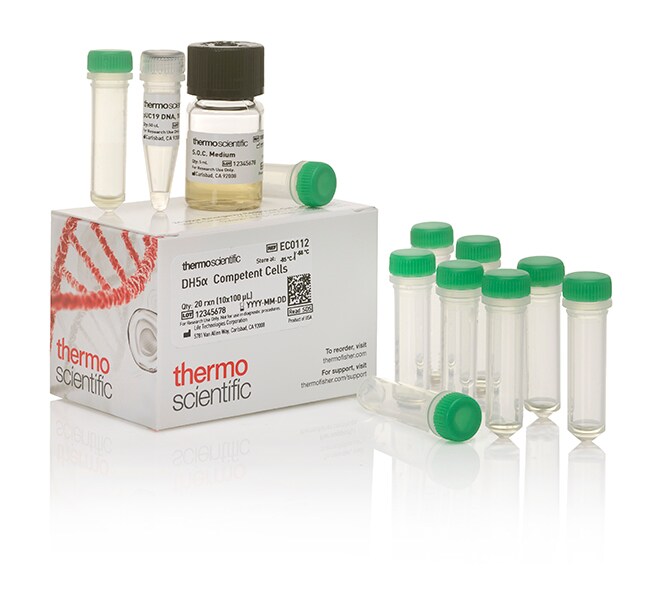Search Thermo Fisher Scientific

DH5α Competent Cells
| Catalog Number | Quantity |
|---|---|
| EC0112 | 10 x 100 μL |
• High transformation efficiency: >1x109 cfu/μg pUC19 DNA
• Suitable for routine and high-throughput cloning applications
• Genetic markers that allow for blue/white colony screening
• Convenient two reactions per vial packaging
• S.O.C. Outgrowth medium included
Applications
DH5α Competent Cells are suitable for variety of applications requiring high transformation efficiency:
• Efficient DNA cloning derived from PCR, cDNA-generation reactions
• recA1 marker facilitates working with difficult to transform DNA
• Ideal for generation of cDNA libraries using plasmid-derived vectors
• Site-directed mutagenesis
Genotype
F– φ80lacZΔ M15 Δ (lacZYA-argF) U169 recA1 endA1 hsdR17 (rK– mK+) phoA supE44 λ- thi–1 gyrA96 relA1
• pUC19 DNA (50 μL) (10 pg/μL)
• S.O.C. Medium (5 mL)
Store at -80°C.
Figures

Customers who viewed this item also viewed
Documents & Downloads
Certificates
Safety Data Sheets
Frequently asked questions (FAQs)
We do not recommend storing competent E. coli strains in liquid nitrogen as the extreme temperature can be harmful to the cells. Also, the plastic storage vials are not intended to withstand the extreme temperature and may crack or break.
We recommend storing our competent E. coli strains at -80°C. Storage at warmer temperatures, even for a brief period of time, will significantly decrease transformation efficiency.
Ensure that you are using the correct antibiotic at the appropriate concentration. Additionally, make sure the antibiotic is not expired. If colonies exhibit unexpected morphologies, contamination could be a factor. Check your S.O.C. medium and LB growth medium.
Here are a few suggestions:
- Small fragments/linkers are cloning in to your vector instead of your insert; to correct this, gel-purify the insert before ligation
- Ensure that the correct concentrations of X-gal and/or IPTG (if vector contains the lacIq marker) are used
- If spreading X-gal and/or IPTG on your plate, allow sufficient time for the reagents to diffuse into the plate
- Incubate your plate for a longer period to ensure full color development
We recommend trying the following:
- Carry out the puc19 transformation control; this gives you information about the performance of the cells.
- Check plates for expiration and correct media used (LB/agar).
- Confirm that the correct antibiotic and concentration was used.